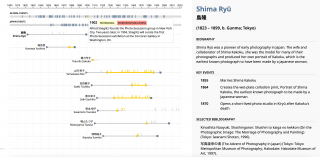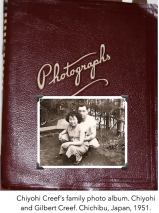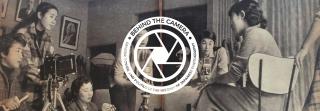-
ARC-iJAC Project Spotlights: An Interview with Kelly Midori McCormick (University of British Columbia) and Carrie Cushman (Hartford Art School) on Expanding the Study of Japanese Photography and Gender: Modules for Teaching and Public Access2023年1月18日(水)
Background:
Kelly Midori McCormick is an assistant professor of Japanese history at the University of British Columbia, Vancouver, specializing in the history of the material and visual culture of modern Japan.
Carrie Cushman is the Edith Dale Monson Gallery Director and Curator at the Hartford Art School. She holds a Ph.D. in Art History from Columbia University and is a specialist in postwar and contemporary art and photography from Japan.
Supported by the ARC-iJAC, their project team has created and launched the bilingual website Behind the Camera--part database, part educational tool--spotlighting a diverse range of international experts on the history of Japanese photography from the perspective of gender and power.Thank you very much for your time today. Could you please tell us about your motivation to start your FY 2021 ARC-iJAC project Expanding the Study of Japanese Photography and Gender: Modules for Teaching and Public Access?
 Prof. McCormick / Prof. Cushman: Conceived in 2017, Behind the Camera was established to address the lack of scholarship and access to primary sources on the histories of Japanese women in photography. The idea for Behind the Camera was sparked with a simple question: what resources existed on the roles that women have played in the history of Japanese photography?
Prof. McCormick / Prof. Cushman: Conceived in 2017, Behind the Camera was established to address the lack of scholarship and access to primary sources on the histories of Japanese women in photography. The idea for Behind the Camera was sparked with a simple question: what resources existed on the roles that women have played in the history of Japanese photography?Since the introduction of the first camera to Japan in 1848, women have been integral to the social constructions of photography as a visual technology, art form, and commercial practice.
Women photographers require a history that intersects social and political history with the close analysis of their work and its implications for visual culture in Japan.
Beyond accounting for historical omissions, we sought ways to interrogate the overwhelmingly male-centered historiography of Japanese photography and to address the ideologies that have consistently reinstated gendered hierarchies within the photography world. We knew that these efforts could not be individual but would require a collaborative, multidisciplinary approach.
To that end, in 2019, we brought together a multidisciplinary group of scholars from Japan, the United States, the United Kingdom, and Israel for a two-part panel at the Association of Asian Studies (AAS) Annual Conference, sponsored by the Japan Art History Forum. The conversations generated at the AAS made clear that the histories of Japanese women in photography required a sustained platform that would allow for research to develop organically and collaboratively.
During the Covid-19 pandemic, the project transformed into a website where specialists share carefully researched arguments and source materials made available to the public in both English and Japanese. In times when travel to archives and conferences is difficult, this website seeks to bring photographs, scholarly perspectives, and historical resources directly to you.
We are delighted about the launch of your digital humanities website Behind the Camera: Gender, Power, and Politics in the History of Japanese Photography.
Can you share some of your experiences with us during the implementation of this project? Have you come across any particular challenges?
 Prof. McCormick / Prof. Cushman: The Art Research Center at Ritsumeikan is an incredible resource for researching Japanese visual culture and producing new information about it. We were thrilled at the opportunity to work with the ARC but the challenges of the Covid-19 pandemic meant that our initial goals of using the recording facilities to conduct interviews with current Japanese women photographers were not possible.
Prof. McCormick / Prof. Cushman: The Art Research Center at Ritsumeikan is an incredible resource for researching Japanese visual culture and producing new information about it. We were thrilled at the opportunity to work with the ARC but the challenges of the Covid-19 pandemic meant that our initial goals of using the recording facilities to conduct interviews with current Japanese women photographers were not possible.We were able, however, to use the generous funding to produce an interview between the photographer Nagashima Yurie and art historian Handa Yuri. This interview will be the first to introduce a wide range of audiences to Nagashima's scholarly work on the history of the Japanese women photographers who gained recognition for their work in the 1990s and Nagashima's critical interpretation of the male photo critics who shaped the way the world saw this generation of women photographers.
Is there anything particularly fascinating you found while implementing this project?
Prof. McCormick / Prof. Cushman: To create the modules for the site, we approached historians of photography to present an issue from the history of Japanese photography from a gender studies perspective. One of the most gratifying things about this project is how many new angles scholars have approached and created their modules from. Many have seen the new format of a video lecture paired with an image archive as a structure that allows them to explore new topics or synthesize larger projects in a compelling and captivating way.

For instance, Dr. Elena Creef drew on networks of Japanese war brides that her mother is a part of to create a collection of family photographs that illustrate their experiences as they moved from Japan to the United States in the postwar period.
While the majority of the modules are focused on historical events, a selection of the modules has been created by curators who reflect on exhibition practices in relationship with the gender histories of Japanese photography.
Maggie Mustard's module on the exhibition she curated, The Incomplete Araki: Life, Sex, and Death in the Work of Nobuyoshi Araki, held at the Museum of Sex, New York in 2018, examines the many challenges with presenting work by the very controversial photographer in the context of the MeToo movement.
Do you have plans to expand this website, for example, by adding new modules? If possible, could you please tell us more about them?
Prof. McCormick / Prof. Cushman: We will be adding a new collection of modules to the website in 2023. We are excited to present lectures by Ayelet Zohar on Ishikawa Mao; Kerry Ross on marketing cameras to women in the Taisho and early Showa period; Judy Legewood on May Ebihara's anthropological photographs in Cambodia; Phillip Charrier's lecture, Shigeo Gocho, women, and everyday resistance in 1960s Japan; Miryam Sas on Rethinking Japanese media theory, and interviews with Eileen Smith on photographing Minamata; and an interview between Komatsu Hiroko and Franz Prichard.
How did you first connect with the Art Research Center (ARC) at Ritsumeikan University? / How did you hear about the International Joint Digital Archiving Center for Japanese Art and Culture (ARC-iJAC)?
We saw a call for applications and after investigating the resources at the ARC were excited to partner with Ritsumeikan in the hopes of spreading the word about the project and collaborating with Japanese scholars.
Is there anything else you would like to comment on or highlight?
We are actively seeking contributors in Japan and around the world who would like to contribute new modules on the history of Japanese photography from new perspectives. Please don't hesitate to reach out if you have a proposal for a module.
(This interview was conducted by Yinzi Emily Li.)















